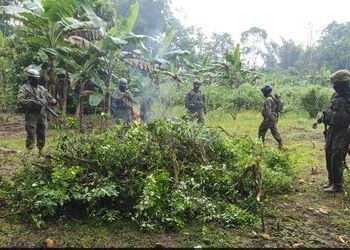Ecuador’s president announced unprecedented coca cultivation figures this week, highlighting the country’s role as a fledgling cocaine producer, though uncertainty remains as to the true extent of coca crops in the South American nation.
Cultivators are growing about 2,000 hectares of coca crops in Ecuador, President Daniel Noboa announced in an October 14 address circulated on local TV stations.
The figure is the first official estimate of coca crop cultivation in Ecuador. Reports by the United Nations Office on Drugs and Crime (UNODC) had previously monitored illicit crops in the country, but never estimated their total area.
SEE ALSO: InSight Crime’s 2023 Cocaine Seizure Round-Up
Noboa said security forces have already launched efforts to eradicate the crops, which are mostly located in northeastern Ecuador along the border with Colombia, the world’s biggest cocaine producer.
“The past opened the doors for us to become a producing country. Today we are closing them,” Noboa said.
The president said that the coca plantations began to appear three years ago, estimating that each hectare is worth $160,000 to criminal groups, putting the total estimated value of coca cultivation in Ecuador today at $320 million.
Noboa said his figures came from “satellite reports obtained with international assistance,” while the United States Bureau of International Narcotics and Law Enforcement (INL) confirmed to InSight Crime that the figures came from an “exploratory” report by the entity.
“The United States provided the Ecuadorian government with information from a US government-funded study based on publicly available satellite data,” the INL said in an email to InSight Crime. It emphasized, however, that “the purpose of this study is informative; there are no definitive conclusions or specific recommendations.”
Coca cultivation in Ecuador is dwarfed by its neighbors to the north and south, Colombia and Peru, the world’s two biggest producers of the crop. Recent estimates show coca cultivation at 230,000 and 95,000 hectares in Colombia and Peru, respectively, while Bolivia is the world’s third-largest cultivator at around 40,000 hectares.
Small plots of coca have been found in other Latin American nations like Venezuela, Honduras, Mexico, and Guatemala, though there has not been comprehensive monitoring of the total area of plots in these countries. Guatemala eradicated just 29 hectares of coca in 2022, and Honduras 140 in the first nine months of 2022, suggesting that cultivation in these countries remains minimal.
Noboa’s coca announcement comes as the government continues an unprecedented crackdown on criminal groups, which have become more sophisticated and violent as Ecuador has become more central to transnational cocaine trafficking routes over the last decade. The military has taken a leading role in the organized crime fight and seized control of the prison system, but homicides and other crimes remain extremely high.
InSight Crime Analysis
Coca cultivation in Ecuador is largely driven by dynamics in neighboring Colombia, though more information is needed on its actual reach.
Colombian groups have long taken advantage of the porous border with Ecuador, sheltering there to avoid Colombian law enforcement crackdowns, as well as to coordinate drug trafficking routes through Ecuador. Still, the UNODC found that coca in Ecuador was “very scarce” in a 2015 report.
SEE ALSO: Unmasking the Foreign Players on Ecuador’s Criminal Chessboard
This may have changed in recent years as coca cultivation has rapidly expanded in the two Colombian departments bordering Ecuador, Nariño and Putumayo. Colombian groups driving coca cultivation see the limited state presence and identical environmental conditions just across the border in Ecuador as an opportunity for a natural extension of its operations.
Ecuadorian authorities have so far identified a number of cocaine processing labs in Ecuador near the border. In April, the military dismantled a lab near the border with a production capacity of up to 10 tons of cocaine per week. These labs are frequently connected to Colombian criminal groups, and authorities have yet to provide evidence that Ecuador’s increasingly powerful criminal groups are involved in cocaine production.
Noboa’s coca estimate makes Ecuador the world’s fourth largest coca-cultivating nation, well behind the “big three” coca-producing nations, but ahead of other fledgling producers in Central America. However, some security experts believe the figure to be an overestimate.
“We identified some crops, but they were very small — marijuana, poppy, and very little coca plant,” a former Ecuadorian anti-narcotic police official with extensive experience in the border region who asked to remain anonymous for security reasons, told InSight Crime. “Talk of 2,000 hectares seems exaggerated.”
Politics may be a primary motive behind Noboa’s coca crops announcement. He has consistently appeared at the site of military operations in a helmet and bulletproof vest, boasted homicide reductions, and blamed predecessors for security problems, all in an attempt to boost electoral capital ahead of the February 2025 presidential elections.
“He’s conveying the message that previous governments allowed the country to be permeated by narco-terrorist groups and that this administration is combating them,” the former police official told InSight Crime, reflecting a sentiment expressed by security experts to local media.
A lack of comprehensive monitoring, however, means the true extent of cultivation will remain a contentious issue. The exploratory INL report, from which Noboa’s claims are based, emphasized the need for a “field investigation” to “corroborate the information obtained from the satellite analysis.” The UNODC, which extensively monitors coca’s reach in Colombia every year, currently does not do the same in Ecuador.
Featured image: Soldiers burn a pile of uprooted coca plants during a March 2024 operation in the Ecuadorian province of Sucumbíos. Credit: X @FFAAECUADOR
Source link : http://www.bing.com/news/apiclick.aspx?ref=FexRss&aid=&tid=67196d6691334dc6b6f233f1dd78b566&url=https%3A%2F%2Finsightcrime.org%2Fnews%2Fecuador-coca-producer-country-says-noboa%2F&c=4520767504647335628&mkt=en-us
Author :
Publish date : 2024-10-23 03:06:00
Copyright for syndicated content belongs to the linked Source.
